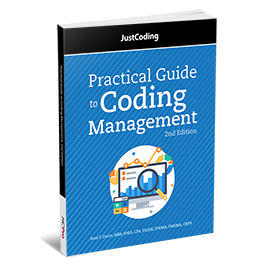JustCoding's Practical Guide to Coding Management, Second Edition
Rose T. Dunn, MBA, RHIA, CPA, FACHE, FHFMA, CHPS
ICD-10 has been fully implemented for more than three years, fundamentally changing how coding managers assess the productivity of coders, the quality of their work, the number of coders available in the workforce, the need for coder education and training, and the need for auditing. Coding managers must continue to update their strategies to keep up with everchanging code and regulation updates.
JustCoding’s Practical Guide to Coding Management, Second Edition, will give coding managers the latest benchmarks, standards, and tips so they can ensure they’re running an effective department. It will give them strategies to retain coders and provide best practices on how to balance internal and outsourced coders and how to manage on-site and remote staff.
To help managers to find a balance between coder productivity and accuracy, this book provides detailed findings from a recent, nationwide coding productivity survey. The survey provides insight from coding professionals on the types of facilities they work in, their everyday challenges, and their facility’s expectations for coding productivity and accuracy.
Additionally, this newest edition includes a sample telecommuting agreement and looks at what is ahead for ICD-11 and E/M code updates.
This book will help managers:
- Conduct internal coding audits and quality reviews
- Effectively hire and train staff
- Establish accuracy and productivity benchmarks
- Understand the role of external entities involved in monitoring coding
- Monitor the impact of the 2021 E/M updates and prepare for ICD-11
Available: September 2019
Pages: 198
Format: 8.5 x 11
ISBN: 978-1-68308-950-6
Table of Contents
Chapter 1: Introduction to Coding and Management
- What Is Coding?
- When Did Coding Begin?
- Who Are Coders?
- What Is Management?
- Summary
Chapter 2: Effective Coding Work Environment
- Organizing the Coding Function
- Other Coding Duties
- Scheduling
- Location and Space
- Workspace, Equipment, and Technology
- Reporting Structure
- Summary
Chapter 3: Staffing the Coding Function
- Staffing Considerations
- How Much Staff Is Needed?
- Recruiting Applicants
- Interviewing Applicants
- Orienting the New Employee
- When the Right Applicant Can’t Be Found
- Scheduling
- Monitoring
- Summary
Chapter 4: Coding Compliance and External Forces
- Compliance Environment
- Personal Compliance Initiatives
- Other Coding Compliance Requirements
- Qui Tam
- Summary
Chapter 5: Coding Compliance Policies and Plans
- Coding Compliance Policy
- Coding Compliance Plan
- Coding Audits
- Corporate Integrity Agreements
- Summary
Chapter 6: Putting the Coding Compliance Plan into Action
- Selecting the Topic
- Selecting the Audit Sample
- Calculating Accuracy
- Summary
Chapter 7: ICD-10 and Looking to the Future with ICD-11
- ICD-10
- Addressing Productivity
- Challenges to Coding Within the “Hold” Period
- Using Benchmarks
- Collecting Data from Your Team
- Communicating the Expectation
- What Are Other Organizations Seeing?
- Fair Distribution of Work
- What’s Ahead with ICD-11
- Summary
Chapter 8: Physician Documentation
- Physician Documentation—The Source for Coding
- At the Office
- Helping the Physician Help Us
- Clinical Documentation Improvement Programs
- Can Technology Help?
- Is This Fraud?
- CDIP Effectiveness
- Summary
Chapter 9: Unique Challenges and Uses of Coded Data
- Hospital and Healthcare Organization Quality Measures
- E/M Coding
- Unspecified
- Patient Safety Initiatives
- Registry Reporting
- ICD-11 and Associated Vocabularies and Classifications
- Hierarchical Condition Categories
- Summary
Chapter 10: Coding’s Role in the Revenue Cycle
- Revenue Cycle—What is it?
- Coding Connects the Cycle
- Preregistration and Scheduling
- Coverage Approvals (Precertification vs. Preauthorization)
- Patient Access
- Case Management
- Patient Care
- Patient Financial Services
- Health Information Management
- Denial Management
- Decision Support
- Managed Care Contracting
- Finance
- Credentialing
- Summary
Chapter 11: Summarizing Important Points
Appendix
About the Authors
Rose T. Dunn, MBA, RHIA, CPA, FACHE, FHFMA, FAHIMA, CHPS, is a past president of the American Health Information Management Association (AHIMA) and recipient of its 1997 Distinguished Member and 2008 Legacy awards. In 2011, she served as the interim CEO of AHIMA and received a Distinguished Service Award from its board of directors. Dunn is the chief operating officer of First Class Solutions, Inc., a health information management (HIM) consulting firm based in St. Louis.
Dunn began her career as director of medical records at Barnes Hospital, which at that time was a 1,200-bed teaching hospital in St. Louis; it is now the flagship hospital of the BJC HealthCare system. Early in her career at Barnes, she became vice president and was responsible for more than 1,600 employees and new business development. Dunn later joined Metropolitan Life Insurance Company, where she served as assistant vice president in MetLife’s HMO subsidiary. She also served as chief financial officer of a dual hospital system in Illinois and was heavily involved in its successful bond application.
Her consulting firm, First Class Solutions, focuses on HIM-related services, including coding support, coding audits, regulatory compliance, and operations improvement in both the acute and post-acute care environment. Dunn assists clients with their operational, revenue cycle, compliance, and strategic planning needs. She and her team of HIM and Coding Professionals supports more than 125 hospitals, physician practices, and skilled nursing facilities with operational, coding, and compliance services. It is from this broad experience base that allows Rose to share everyday guidance in her book.



 If for any reason you are not completely satisfied with an HCPro product, simply return it within 30 days of purchase and we will issue you a full refund.*
If for any reason you are not completely satisfied with an HCPro product, simply return it within 30 days of purchase and we will issue you a full refund.*